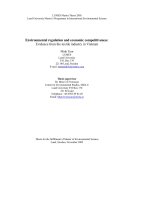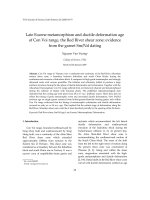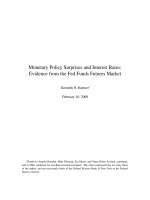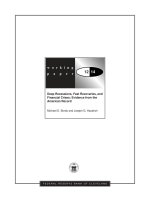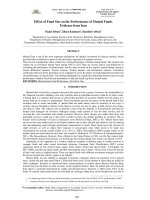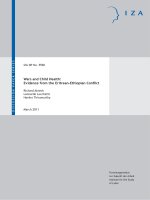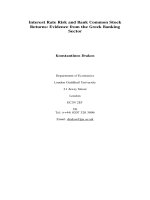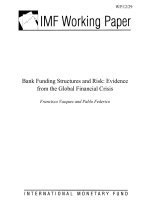Industrial clustering, firm performance and employee welfare evidence from the shoe and flower cluster in ethiopia
Bạn đang xem bản rút gọn của tài liệu. Xem và tải ngay bản đầy đủ của tài liệu tại đây (2.32 MB, 238 trang )
75
Tigabu Degu Getahun studied economics at the University of Copenhagen
and the University of Bonn. He is a Senior Researcher at the University of
Bonn and a Research Fellow at the Ethiopian Development Research Institute
(EDRI) in Ethiopia.
www.peterlang.com
DEP 75_266744_Getahun_GR_A5HC PLA.indd 1
DEVELOPMENT ECONOMICS
AND POLICY
Series edited by Joachim von Braun, Ulrike Grote and Manfred Zeller
75
Tigabu Degu Getahun · Industrial Clustering, Firm Performance and Employee Welfare
The author examines the productivity, profitability and welfare effects of industrial clustering and a public policy promoting industrial clusters in Ethiopia. He
uses reliable counterfactuals as well as original enterprise and worker level
data. By investigating the effect of firm, time, entrepreneur and site specific
factors as well as endogenous location choice issues, the author finds strong
evidence for the existence of significant agglomeration economies in the Ethiopia leather footwear cluster. Using primary survey data collected from firms
which benefited from the cluster policy and those that did not, both before and
after the implementation of the policy, the author shows the unintended negative
impact of a cluster prompting policy in Ethiopia. The book is essential reading
for those who are interested in the gender and welfare impact of female full
time labor force participation in industrial jobs.
Industrial Clustering, Firm Performance
and Employee Welfare
Evidence from the Shoe
and Flower Cluster in Ethiopia
Tigabu Degu Getahun
Umschlaggestaltung:
© Olaf Gloeckler, Atelier Platen, Friedberg
Cover Design:
© Olaf Gloeckler, Atelier Platen, Friedberg
Conception de la couverture du livre:
© Olaf Gloeckler, Atelier Platen, Friedberg
ISBN 978-3-631-66744-6
11.02.16 KW 06 17:27
Industrial Clustering, Firm Performance and Employee Welfare
DEVELOPMENT ECONOMICS
AND POLICY
Series edited by Franz Heidhues †, Joachim von Braun,
Ulrike Grote and Manfred Zeller
Vol. 75
Industrial Clustering, Firm Performance
and Employee Welfare
Evidence from the Shoe
and Flower Cluster in Ethiopia
Tigabu Degu Getahun
Bibliographic Information published by the Deutsche Nationalbibliothek
The Deutsche Nationalbibliothek lists this publication in the Deutsche
Nationalbibliografie; detailed bibliographic data is available in the internet at
.
Zugl.: Bonn, Univ., Diss., 2015
Library of Congress Cataloging-in-Publication Data
Names: Getahun, Tigabu Degu, 1980Title: Industrial clustering, firm performance and employee welfare : evidence
from the shoe and flower cluster in Ethiopia / Tigabu Degu Getahun.
Other titles: Development economics and policy ; v. 75.
Description: New York : Peter Lang, 2016. | Series: Development economics
and policy ; vol. 75 | doctoral Universität Bonn 2015.
Identifiers: LCCN 2016006143 | ISBN 9783631667446
Subjects: LCSH: Industrial clusters—Ethiopia. | Shoe industry—Ethiopia. |
Floriculture—Ethiopia. | Women—Employment—Ethiopia.
Classification: LCC HC845.Z9 D54 2016 | DDC 338.70963—dc23 LC record
available at />D 98
ISSN 0948-1338
ISBN 978-3-631-66744-6 (Print)
E-ISBN 978-3-653-06378-3 (E-Book)
DOI 10.3726/978-3-653-06378-3
© Peter Lang GmbH
Internationaler Verlag der Wissenschaften
Frankfurt am Main 2016
All rights reserved.
PL Academic Research is an Imprint of Peter Lang GmbH.
Peter Lang – Frankfurt am Main · Bern · Bruxelles · New York ·
Oxford · Warszawa · Wien
All parts of this publication are protected by copyright. Any
utilisation outside the strict limits of the copyright law, without
the permission of the publisher, is forbidden and liable to
prosecution. This applies in particular to reproductions,
translations, microfilming, and storage and processing in
electronic retrieval systems.
This publication has been peer reviewed.
www.peterlang.com
Abstract
Despite the number of empirical case studies on industrial clustering since the
seminal work of Marshall (1920), only very few have made significant attempts
to quantify its productivity, profitability and welfare effects. This study examines
the productivity, profitability and welfare effects of industrial clustering and a
public policy promoting industrial clusters in Ethiopia. To this end, firm-level
survey data were collected from 196 leather shoe manufacturers that were part of
the spontaneously emerged leather shoe cluster in Ethiopia, 86 firms that operated in a separate government created cluster, and 72 non-clustered firms located
in other areas.
The study employs appropriate estimation strategies to disentangle the effect
of industrial clustering from firm heterogeneities and other cofounders. The estimation results from both the random effect model and the Abadie and Imbens
(2011) bias corrected nearest neighbor matching model reveal the productivity
and profitability increasing effect of industrial clustering, after controlling for the
effects of site-, enterprise-, entrepreneur-, and time- specific factors. The study
also accounts for selection bias and endogenous location choice problem.
The results from the two way fixed effect impact evaluation model suggests
that the implemented government cluster development program in Ethiopia has
adversely impacted the productivity, profitability, growth, and innovation performance of the treated firms. Due to the short span of the program, however,
these findings only reflect the short-term impacts of the program.
The regression result from the Mincerian earning function indicates that clustered firms paid higher mean wages compared to non-clustered counterparts;
implying a welfare increasing effect of industrial clustering. In addition, the results of a correlation matrix analysis disclose a positive and significant correlation between firm productivity and the number of employees, again implying
positive welfare effects of industrial clustering. The results of a gender disaggregated analysis of employment effects also reveals a positive relationship between
gender equity and industrial clustering.
To further explore the welfare and gender impacts of industrial clustering,
the study empirically investigates the intra-household welfare impacts of formal
salaried employment of women in the most female dominated cluster in Ethiopia, the cut flower industry cluster. To this end, a unique quantitative survey was
conducted with a random sample of 670 women working in the cut flower cluster
5
and a control group of 182 women who applied for work in the cluster but were
unsuccessful.
The relevance tests of the hypotheses and results of a special maximum likelihood estimation model, an endogenous binary treatment model, and difference
in difference models combined with instrumental variable estimators all suggest
that, compared to employment elsewhere, salaried employment of women in the
cut flower cluster improved the income and consumption welfare of the working women and their household. It also (i) has negative relationships with the
incidence and depth of poverty; (ii) has reduced the food insecurity and hunger
status of working women and their households; (iii) has improved the bargaining and decision making power of the flower working women (iv) has transformed the traditional gendered patterns of intra household time use and (v) has
negative relationships with the leisure demand of the flower working women and
their close substitutes.
The investigation of the transmission mechanisms further suggests that increases in women’s earnings derived from employment in the cut flower cluster
has effected the consumption welfare of the flower working women’s household
not only through the usual Marshallian income and substitution effects, but also
through the distinguishing bargaining effect. The qualitative findings support the
quantitative findings, but unveil additional intangible benefits and costs of female
labor force participation.
6
Zusammenfassung
Trotz des Anstiegs von empirischen Cluster Fallstudien seit der wegweisenden
Arbeit von Marshall (1920), haben nur wenige dieser Studien versucht, Produktivitäts-, Profitabilitäts-, und Wohlfahrtseffekte des industriellen Clusterings zu
quantifizieren. Die vorliegende Studie analysiert deshalb empirisch Produktivitäts- und Profitablitätseffekte des industriellen Clusterings sowie einer staatlichen
Politik zur Föderung von industriellen Clustern in Äthiopien unter Verwendung
von neu erhobenen Umfragedaten auf Firmenebene in 196 Lederschuhe produzierenden Firmen, die in einem spontan entstandenen Lederschuhcluster in Äthiopien operieren; außerdem 86 Firmen, die in einem von der Regierung initiierten
Cluster operieren sowie 72 Firmen, die außerhalb von Clustern operieren.
Die Studie nutzt verschiedene Schätzstrategien, um die Effekte des Clusterings
von Firmen-Heterogenitäten und anderen Faktoren zu trennen. Schätzergebnisse aus dem Random Effect Modell und dem von Abadie und Imbens (2011)
Bias-korrigierten Nearest Neighbor Matching Schätzer zeigen einen zunehmenden Effekt des industriellen Clusterings auf Produktivität und Profitabilität,
nachdem für Effekte von natürlichen Gegebenheiten sowie Firma-, Unternehmer- und zeitabhängigen Faktoren kontrolliert wird. Die Studie berücksichtigt
sowohl Selektionsverzerrungen als auch endogene Standortwahlprobleme.
Schätzergebnisse des am weitesten verbreiteten Impaktevaluationsmodells,
dem Difference in Difference-Modell, zeigen an, dass das implementierte Cluster-Entwicklungsprogramm der Regierung adverse Effekte bezogen auf Profitabilität, Wachstum, Innovation und Produktivität hat. Jedoch bezieht sich dieses
Resultat, aufgrund der kurzen Zeitspanne des Programms, nur auf den unmittelbaren kurzfristigen Effekt des Programms.
Regressionsresultate aus Mincer-Typ-Einkommensfunktionen zeigen, dass
Cluster Firmen im Durchschnitt höhere Löhne für ihre Arbeiter zahlen als
entsprechende Nicht-Cluster Firmen, was auf einen positiven Wohlfahrtseffekt des industriellen Clusterings hinweist. Außerdem zeigt die Analyse der
Korrelationsmatrix eine positive und signifikante Korrelation zwischen der
Produktivität der Firma und der Höhe der Beschäftigung an, was wiederum
positive Wohlfahrtseffekte des industriellen Clusterings widerspiegelt. Die Disaggregation des Beschäftigungseffekts nach Geschlecht deutet auf eine Reduzierung der Geschlechterdisparität hin.
Um den Effekt auf Wohlfahrt und Geschlecht weiter zu erkunden, untersucht die Studie den Intra-Haushaltseffekt der Lohnbeschäftigung von Frauen
7
in einem der von Frauen am meisten dominierten Cluster in Äthiopien – dem
Blumencluster. Dafür wurden einzigartige quantitative Umfragedaten mittels
Zufallsstichprobe erhoben von (i) 670 Frauen, die im Blumencluster eine Beschäftigung aufgenommen haben und (ii) einer Kontrollgruppe von 182 Frauen,
die sich beworben hatten, aber keine Beschäftigung aufgenommen haben.
Der Relevanztest der Hypothese und die Schätzergebnisse des Maximum
Likelihood-Schätzmodells, des Treatment Effect-Modells, des mit Matching
kombinierten Difference in Differences-Modells und des Instrumentalvariablenschätzers zeigen alle an, dass Lohnbeschäftigung von Frauen im Blumencluster, verglichen mit sonstiger Beschäftigung, den arbeitenden Frauen und deren
Haushalten dazu verhilft (i) die Inzidenz und den Schweregrad der Armut zu
reduzieren, (ii) Hunger und Nahrungsmittelunsicherheit bei den beschäftigten
Frauen und deren Haushalten zu verringern, (iii) die Verhandlungsposition und
Entscheidungsbefugnisse der Frauen zu verbessern and (iv) die Nachfrage der
im Blumensektor beschäftigten Frauen nach Freizeit zu verringern.
Interessanterweise deutet die Analyse zusätzlich darauf hin, dass die Erhöhung
des Einkommens der Frauen aufgrund der Beschäftigung im Blumencluster signifikant die kollektive Haushaltsnachfrage beeinflusst und zwar nicht nur durch einen gewöhnlichen Marshall’schen Einkommens- und Substitutionseffekt, sondern
auch durch einen differentiellen Verhandlungseffekt. Während die qualitativen
Resultate die quantitativen Resultate unterstützen, decken sie zusätzlich weitere,
schwieriger zu greifende Nutzen und Kosten der weiblichen Teilnahme an der Erwerbstätigkeit auf.
8
Acknowledgement
It is a great pleasure to thank God, the many people and institutes who made this
book possible. First and foremost glory to the Almighty for enabling me to accomplish my writing successfully. My boundless gratitude goes to my first Professor
Dr. Joachim Von Braun. Throughout my thesis-writing period, he provided encouragement, sound advice and lots of good ideas. I would have been lost without
him. It has been an honor to be his student. I am also very grateful for my second
Professor Dr. Ulrich Hiemenz and my Dr. Marc Müller who took time to review
my work. I am also greatly indebted to my research partner and friend Dr. Espen
Villanger for his continued encouragement, support and inspiration.
I am heavily indebted to H.E Ato Newai Gebre-ab, EDRI director and chief
economic advisor to the Ethiopia government prime minister, for his invaluable
advice, encouragement, moral support and easy yes for all my difficult requests. I
would also like to wholeheartedly thank Mrs Rosemary Zabel, Mrs Maike Retat
Amin and Dr. Gunther Manske for their excellent admin and logistic assistance.
I would also like to take this opportunity to gratefully acknowledge the funding sources that made my doctoral study possible. The first three years of my
study was primarily funded by the German Academic Exchange Service while
part of my last year study was funded by BMZ through ZEF. My field research was
mainly funded by the Dr. Hermann Eiselen grant program of the Fiat Panis foundation. Part of my work was also financially supported by IDRC through EDRI.
My time at Bonn was made enjoyable due to the many friends, fellow students and colleagues. Daniel Ayalew, Lukas Kornher, Million, Negash, Christine
Husmann and Robert Poppe thank you so much for making my time in Germany
more enjoyable. Christine and Robert thank you so much for the German translation of my abstract. Nuru Yasin, Hussein Ahmed, Abdurrahman Ali, Ibrahim
Worku, Feiruz Yimer, Biruk Teklie, Dr. Girum Abebe, Dr. Seid Nuru, Ato Mezgebe
Mihretu, Bedilsh, Desta Solomon, Laura Kim and friends and colleagues at EDRI,
please accept my sincerest appreciation for being always with me in all my difficult
times; and for providing all the emotional supports and comraderies.
Dr. Seid and Dr. Assefa, many thanks for believing on me and recommending
me to study in the University of Bonn, Center for Development. I hope I have
not failed you.
9
Last, but not the least, I am forever indebted to my entire extended families.
Words cannot express how grateful I am to my mom Tsehaynesh Kebede and
late grand mom Nurit Nigatu for all of the sacrifices they made on my behalf. My
sweet kids Nebil Tigabu and Jasmin Tigabu, you are my real source of pleasure
and call to action. Thank you so much for always cheering me up.
10
Contents
List of Tables.............................................................................................................15
List of Figures...........................................................................................................19
List of Acronyms.....................................................................................................21
1. General Introduction......................................................................................23
1.1Background..................................................................................................23
1.2 Literature Review and Experimental Hypotheses...................................26
1.3 Research Problem and Significance of the Study....................................35
1.4 Research Objectives and Questions..........................................................39
1.5Methods........................................................................................................40
1.6 Structure of the Book..................................................................................42
2. Industrial Clustering and Firm Performance:
The Ethiopian Leather Shoe Industry.......................................................45
2.1Introduction.................................................................................................45
2.2 Overview of the Ethiopian Leather Shoe Industry.................................48
2.3 Conceptual Framework..............................................................................51
2.4 Survey Design, Data and Measurement...................................................55
2.5 Characteristics of Sample Enterprises......................................................61
2.6 Firm Location Choice.................................................................................68
2.7 Industrial Clustering, Firm Performance and
Employee Welfare........................................................................................70
2.8 Estimation Strategy and Results................................................................79
2.9 Transmission Mechanisms.........................................................................88
11
2.9.1 The Leather Footwear Cluster and its Supply Chain.................... 88
2.9.2 Industrial Clustering and Small Firm Growth Barriers............... 97
2.10 Concluding Remarks............................................................................... 100
3. Impacts of the Cluster Development Program in Ethiopia........... 103
3.1Introduction.............................................................................................. 103
3.2 Data and Sampling Method.................................................................... 106
3.3 Pre-Intervention Characteristics of Sample Firms.............................. 108
3.4 Potential Impacts of the MSME Cluster Development Program..........112
3.5 Evaluation Methods, Results and Discussions..................................... 114
3.5.1 Evaluation Methods........................................................................ 114
3.5.2 Estimation Results and Discussions............................................. 117
3.6 Concluding Remarks............................................................................... 132
4. Welfare and Gender Impacts of Female
Employment in an Industry Cluster:
Evidence from the Flower Cluster in Ethiopia................................... 135
4.1Introduction.............................................................................................. 136
4.2Context...................................................................................................... 141
4.3 Theoretical Model.................................................................................... 143
4.4 Econometric Model................................................................................. 145
4.5 Sampling Method, Data and Measurements........................................ 147
4.6 Initial Demographic and Socio-Economic Characteristics................ 154
4.7 Estimation Strategy and Results............................................................. 159
4.7.1 Impact on the Monetary Dimension of Wellbeing..................... 160
4.7.2 Impact on the Non-Monetary Dimension of Wellbeing............ 181
4.7.3 Gender Roles.................................................................................... 186
4.7.4 Transmission Mechanism: Drivers of the Observed
Welfare Changes.............................................................................. 194
4.8 Concluding Remarks............................................................................... 199
12
5.Conclusion....................................................................................................... 203
5.1Synopsis..................................................................................................... 203
5.2 Limitations of the Study and Suggestions for Future Research.......... 206
References............................................................................................................... 209
Annexes................................................................................................................... 225
13
List of Tables
Table 2.1:
Table 2.2:
Table 2.3:
Table 2.4:
Table 2.5:
Table 2.6:
Table 2.7:
Table 2.8:
Table 2.9:
Table 2.10:
Table 2.11:
Table 2.12:
Table 2.13:
Table 2.14:
Table 2.15:
Table 2.16:
Table 2.17:
Years of Operation of the leather footwear manufacturers.............. 62
Initial numbers of workers among leather footwear
manufacturers........................................................................................ 62
Sources of Initial Investment and Working Capital.......................... 63
Percentages of formally registered leather shoe
manufacturers in Ethiopia.................................................................... 64
Characteristics of leather shoe manufacturer entrepreneurs
in Ethiopia, 2013.................................................................................... 65
Site-specific factors of leather manufacturing firms in
Ethiopia, 2013........................................................................................ 68
Major reasons for firm location choice among leather shoe
manufacturers, 2013.............................................................................. 69
The performance of clustered and non-clustered leather
shoe industry firms................................................................................ 71
Leather shoe manufacturer marketing channels
by location, 2013.................................................................................... 74
Wage rates, Number of employees and Growth among
Leather shoe manufacturers................................................................. 76
Work experience among employees of clustered and
non-clustered leather shoe manufacturers in Ethiopia, 2013..............77
Percentages of female workers in the leather shoe industry
in Ethiopia, 2013.................................................................................... 78
Nearest neighbor matching estimates of industrial clustering
effects on the leather shoe manufacturers’ performance.................. 80
Random effect estimates of the industrial clustering effects
on the leather shoe manufacturers Performance.............................. 82
Regression estimates of the earning function of cluster
impacts on the leather shoe Manufacturers, 2013............................. 88
Percentages of Shoe manufacturers that collaborate
frequently with other Manufacturers, 2013....................................... 92
Relationship Between firm performance and horizontal
collaboration in the leather shoe industry in Ethiopia, 2013...............95
15
Table 2.18: Relationship between firm performance and downstream
collaboration.......................................................................................... 95
Table 2.19: Relationship between firm performance and upstream
collaboration.......................................................................................... 96
Table 2.20: Mean scores of small firm growth constraints in the leather
shoe industry, 2013................................................................................ 98
Table 3.1: Pre-Intervention Entrepreneur characteristics................................ 109
Table 3.2: The Characteristics of the Control and treatment Firms
before the implementation of the cluster policy.............................. 110
Table 3.3: Mean monthly performance indicator values among control
and treatment leather shoe manufacturers before the
implementation of the cluster policy................................................ 112
Table 3.4: The performance of treatment and control firms in 2010 and
2013....................................................................................................... 113
Table 3.5: The DID Estimates of the impacts of the cluster
development program......................................................................... 118
Table 3.6: Business network effects of the cluster development policy:
DID model results............................................................................... 122
Table 3.7: Impacts of cluster policy on information and experience
exchange collaboration....................................................................... 124
Table 3.8: Percentage of Shoe manufacturers that collaborated
frequently with similar firms in the leather shoe industry in
Ethiopia................................................................................................. 125
Table 3.9: The mean value of Small firm growth constraint indicators
in the leather shoe industry in Ethiopia........................................... 130
Table 4.1: Education and Experience of the Women and
Their Spouse..............................................................................................155
Table 4.2: Demographic Characteristics............................................................ 157
Table 4.3: Initial Economic Condition of the Respondent by
Participation Status.............................................................................. 158
Table 4.4: The Initial Characteristics of the respondent Parent...................... 159
Table 4.5: Potential Impact of female Flower Job employment....................... 160
Table 4.6: DID Estimation of Female Employment Impact on Wage
and Non-wage Income........................................................................ 163
Table 4.7: The FIML Estimates of Selection & Consumption Welfare
Equation................................................................................................ 167
16
Table 4.8:
Table 4.9:
Table 4.10:
Table 4.11:
Table 4.12:
Table 4.13:
Table 4.14:
Table 4.15:
Table 4.16:
Table 4.17:
Table 4.18:
Table 4.19:
Table 4.20:
Table 4.21:
Table 4.22:
Table 4.23:
Table 4.24:
Table 4.25:
Table 4.26:
Table 4.27:
Table 4.28:
The Computed ATE and ATET values based on the
Consumption Function Estimates..................................................... 169
DID, FE, DID_GMM and DID-3SLS Estimate of
Consumption Welfare......................................................................... 171
Annual expenditure on clothing, cloth, tailoring and
footwear (Birr), 2013........................................................................... 172
Impact on Poverty Incidence............................................................. 174
The Probit Model estimate of the Poverty Impact of Female
Employment......................................................................................... 175
The FIML Estimates of log of per Adult Food Consumption
Equations.............................................................................................. 176
The Computed ATE and ATET values based on the food
Consumption Function Estimates..................................................... 177
Impact on Food consumption........................................................... 178
Percentage of children and adults who ate one, two three
and four times per day........................................................................ 179
Percentage of household members who ever sleep hungry
last week,2013...................................................................................... 179
Food Insecurity and hunger Status Level-Categorical.................... 180
Impact on Food Insecurity and Hunger
scale-Continuous................................................................................. 180
Women’s Own Happiness Assessment, 2013................................... 181
Impact on Intra-Household Leisure Time
Allocation, 2013................................................................................... 183
Percentage of Member women and
Average Social Capital Score, 2013.................................................... 185
Access to Emergency Fund................................................................ 185
Average Monthly hour the women spend on
domestic work...................................................................................... 188
Intra-Household Earning Difference................................................ 189
Determinants of Women’s Control over
Household Finance.............................................................................. 190
Women Contribution to household expenditure............................ 191
Percentage of Women Who Disagree with the Following
Gender Inequitable Statements.......................................................... 192
17
Table 4.29: Self-confidence: Percentage of women who
agree with the following statement................................................... 193
Table 4.30: Determinants of Consumption Welfare and
Food Insecurity.................................................................................... 195
Table 4.31: Determinants of Leisure Demand..................................................... 198
18
List of Figures
Figure 2.1: Initial start-up working and fixed capita reported by leather
shoe manufacturers............................................................................... 72
Figure 2.2: Sources of competition among leather shoe manufacturers
according to firm owners own rating, 2013............................................73
Figure 2.3: Engagement in innovative activities among leather shoe
manufacturers, 2013.............................................................................. 75
Figure 2.4: Primary firm-level innovation motivation among leather
shoe manufacturers, 2013..................................................................... 75
Figure 2.5: Percentages of sales value by mode of payment in the leather
shoe industry, 2013................................................................................ 90
Figure 2.6: Percentages of Leather shoe manufacturers that collaborated
frequently with input suppliers, 2013................................................. 93
Figure 2.7: Percentages of leather shoe manufacturers that collaborate
frequently with shoe traders, 2013...................................................... 94
Figure 3.1: Percentages of shoe manufacturers that collaborated
frequently with input suppliers in the leather shoe industry
in Ethiopia............................................................................................ 126
Figure 3.2: Percentages of shoe manufacturers that collaborated
frequently with shoe traders in the leather shoe industry in
Ethiopia................................................................................................. 127
Figure 4.1: Previous Occupation of the Flower Job
Participating Women.......................................................................... 154
Figure 4.2: Previous Occupation of the Non-participating/control
women................................................................................................... 155
Figure 4.3: Potential Income Impact of flower Job Participation..................... 162
Figure 4.4: Summary of Changes in Intra-household Wellbeing..................... 173
Figure 4.5: Intra-household allocation of domestic responsibilities................ 186
Figure 4.6: Intra-household domestic work burden for the Participating
women................................................................................................... 187
Figure 4.7: Percentage of the women who were involved in the final
household decisions............................................................................ 194
19
List of Acronyms
ADLI
ATT
ATET
BMZ
CSA
DAAD
DID
GMM
EIFCCOS
EDRI
ETB
ESSP
FDRE
FeMSEDA
FGD
GIZ
GPRG
GRIPS
GTP
ICT
IDS
IFPRI
IV
LDI
LLPTI
MoFED
MSME
MLE
OECD
OLS
Agricultural Development Led Industrialization
Average Treatment Effect
Average Treatment Effect on the Treated
German Federal Ministry for Economic Cooperation and Development (BMZ)
Central Statistical Agency
German Academic Exchange Service
Difference in Difference
General Method of Moment
Ethiopia International Foot wear Cooperative Society
Ethiopian Development Research Institute
Ethiopian Birr (currency)
Ethiopian Strategy Support Program
Federal Democratic Republic of Ethiopia
Federal Micro and small Enterprises Development
Agency
Focus Group Discussion
German Development Cooperation
Global Poverty Research Group
Japan National Graduate Institute for Policy Studies
Growth and Transformation Plan
Information communication Technology
Industrial Development Strategy
International Food Policy Research Institute
Instrumental Variable
Leather Development Institute
Leather and Leather Product Technology institute
Ministry of Finance and Economic Development
Micro Small and Medium scale Enterprises
Maximum Likelihood Estimator
Organization for Economic Cooperation and Development
Ordinary Least Square
21
PASDEP
ROSCAS
R&D
SDRP
UN
UNDP
UNIDO
USD
USDA
22
Policy - Plan for Accelerated and Sustained Development to End Poverty
Rotating Saving and Credit Association
Research and Development
Sustainable Development and Poverty Reduction
Program
United Nation
United Nation Development Program
United Nations Industrial Development Organization
United States Dollar
United State Department of Agriculture
1. General Introduction
1.1 Background
Ethiopia has remained a predominately agrarian subsistence economy despite its
long history of civilization. Industry in the modern sense only emerged in the
country during the 1920s.1 Yet, a cognizant effort to stimulate industrial growth
began with the formation of the federal government’s first five-year development plan in 1957. During the 1960s and early 1970s the country enjoyed relatively better industrial performance, although most manufacturers were foreign
owned (Eshetu, 1985; Shiferaw, 1995).
In 1974 a military government came to power that instituted command oriented policies and nationalized virtually all medium- and large-scale industrial
companies owned by both foreigners and Ethiopians. Private ownership was only
permitted for cottage industries and small-scale enterprises during this period. The
strict leftist economic and political ideology pursued by the military government
suppressed private economic activity considerably and subdued entrepreneurial
spirit (Eshetu, 1985; World Bank, 1985).
In 1991 the present civilian government replaced military authorities and
undertook a series of reforms to reorient the economy from a command to a
market economy. Consequently, the private sector began to increase and a remarkable number of micro-, small - and large-scale manufacturing enterprises
emerged spontaneously, mainly in the capital city (Addis Ababa) and its suburbs.
Some of these enterprises are spatially concentrated in few areas, while others
are spatially distributed throughout the country. For example, the vast majority
of micro-, small- and medium-scale leather footwear manufacturers are concentrated in the western part of the capital, while a few are located in other parts of
the capital and surrounding suburbs.
To further accelerate the expansion of manufacturing industries and bring
about structural economic transformation, the Ethiopian federal government
initiated a comprehensive Industrial Development Strategy (IDS) under the
umbrella of the overall national development policy called Agricultural Development Led Industrialization (ADLI)2 in 2002. This strategy was intended to
1 Before the 1920s the production of hand-crafted goods was the major manufacturing
activity in Ethiopia.
2 The ADLI strategy, which was adopted in the mid-1990s as a national economic policy,
presumes that agriculture will play a leading role in the industrialization process by
23
stimulate industrial development by strengthening the linkages between agriculture and industrial sectors (IDS 2002).
In pursuit of this strategy the government started providing various incentives, not only for the agricultural sector, but also for agro-processing and labor
intensive manufacturing industries that have strong linkages to the agricultural
sector (and hence to the rural economy). These supports include tax holidays,
preferential financing such as longer grace and repayment periods, below-market
interest rates, preferential land lease terms (low rates and long-term contracts),
and duty free importation of machinery (GTP 2011). In addition to these general support measures, the Ethiopian federal government also provides special
support to a few priority sectors including the leather goods and cut flower industries. Various special programs that provide support such as benchmarking,
institutional twining, and market research have been implemented since 2002/3.
Subsequently, the Ethiopian economy has registered continuous double-digit
annual growth since 2003/4, placing it among the top performing economies in
sub-Saharan Africa. Over this period the industrial sector has also grown at the
same rate and a remarkable number of privately owned manufacturing enterprises have emerged. Despite these positive achievements, structural transformation
of the economy has not yet been achieved (CSA 2013). The industrial sector has
lingered, however, contributing the least to employment generation and overall
GDP growth, even compared with other sub-Saharan African economies (World
Development Report 2013). In addition, manufacturing has been largely dominated by small- and micro-scale enterprises.3 Strikingly, despite their superior
performance in terms of employment generation, which is surpassed only by
agriculture, the growth and competiveness of micro- and small-scale manufacturing enterprises have also remained limited and the ‘medium-scale’ enterprises
have been overlooked, as is the case in most of other sub-Sahara African economies (Bigsten and Södernbom 2006, Ali and Peerlings 2011).
In the beginning the policy focus of the current government exclusively targeted export-oriented large-scale manufacturers. Even though the small- and
micro-scale enterprises represent the second largest source of employment after
setting up conditions for full-fledged industrialization. The rationale for this strategy is
that, given the predominantly agrarian nature of the economy, industrial development
should rely on and serve agriculture by providing agricultural inputs and consumer
goods (IDS 2002).
3 Small- and medium-scale enterprises in Ethiopia cover more than 95% of the total
number of manufacturing enterprises, and account for the greatest share of off-farm
employment (CSA 2007).
24
